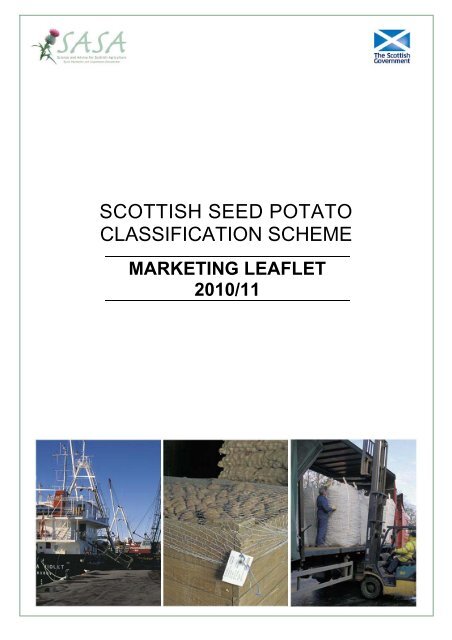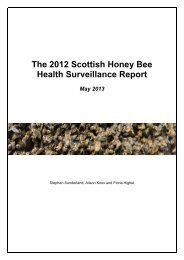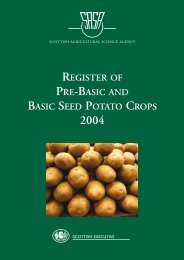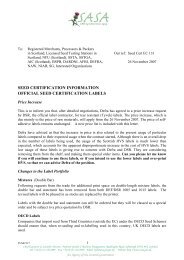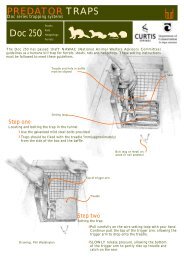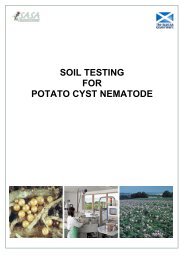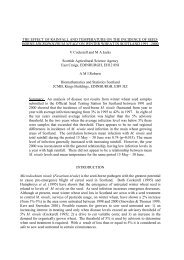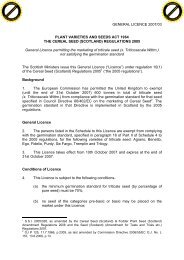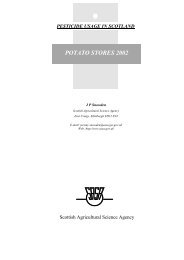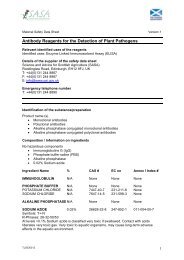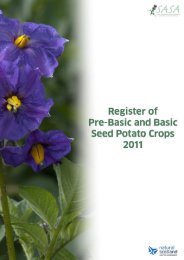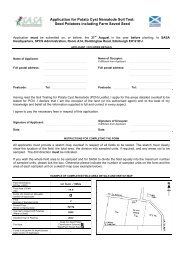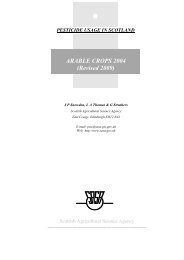SCOTTISH SEED POTATO CLASSIFICATION SCHEME - SASA
SCOTTISH SEED POTATO CLASSIFICATION SCHEME - SASA
SCOTTISH SEED POTATO CLASSIFICATION SCHEME - SASA
You also want an ePaper? Increase the reach of your titles
YUMPU automatically turns print PDFs into web optimized ePapers that Google loves.
<strong>SCOTTISH</strong> <strong>SEED</strong> <strong>POTATO</strong><strong>CLASSIFICATION</strong> <strong>SCHEME</strong>MARKETING LEAFLET2010/11
ForewordMARKETING OF <strong>SEED</strong> <strong>POTATO</strong>ES – 2010/2011There are a number of issues that you should be aware of this season therefore please taketime to read this foreword and leaflet.Dickeya sppIn last years Marketing Leaflet your attention was drawn to a new threat to Scottish potatoes– “Dickeya solani”. At that time the Scottish Government planned to consult with the potatoindustry in Scotland on the matter. That exercise has now been completed and it showedthat there was strong support for measures to tackle this new pathogen in order to maintainScotland’s high health status. Legislation has therefore been introduced that establishes azero tolerance for all Dickeya species within the SPCS (Seed Potato Classification Scheme)from 2010 onwards.Further information about this serious disease and what steps can be taken by you to helpprevent its introduction and spread can be found at:http://www.scotland.gov.uk/Topics/farmingrural/Agriculture/plant/18273/PotatoHealthControls/PotatoQuarantineDiseases/Dickeya.Charlie Laing<strong>SASA</strong> Potato BranchOctober 20101
1 GENERALMarketing of Scottish seed potatoes is governed by the Seed Potatoes (Scotland)Regulations 2000 as amended, Plant Health matters are governed by the PlantHealth (Scotland) Order 2005 and the Plant Health (Potatoes) (Scotland) Order 2006.Fees are determined by the Seed Potatoes (Fees) (Scotland) Regulations 2009. Allseed potato growers and merchants should make themselves aware of therequirements of these Regulations.It is an offence to market seed potatoes if:-a crop inspection report has not been issued for the potatoes;the containers have not been officially labelled and sealed;the tubers have not been inspected in accordance with the Regulations.At all stages of marketing, the "seller" will be the person responsible for complyingwith the Regulations. Any person who sells, consigns or delivers pre-basic or basicseed potatoes shall issue to the purchaser, no later than 14 days after the sale ordelivery of the potatoes, a sale note, delivery note, invoice or similar documentspecifying the following:-Name and address of sellerNet weightVarietyPre-basic or basic seed potatoes (as appropriate)Class and class generation (if shown on the official label)Community grade i.e. EC2 or EC3 (applies only to Basic seed potatoes)SizeCrop identification numberParticulars of any chemical treatmentIt is not acceptable to refer to the details printed on the official labels.The name of any chemical product used to treat seed potato tubers must be statedon suitable labels attached to the packages or containers. It is also possible torequest that the chemical treatment be shown on the official label and in the saledocuments. Further details about chemical treatment are given in section 9.The Regulations define "marketing" as:–selling, holding with a view to sale and offering for sale; andany disposal, supply or transferfor the purpose of commercial exploitation of seed potatoes to third parties, whetheror not for consideration (payment); and “market” and “marketed” shall be construedaccordingly.All seed potatoes moved from the farm on which they were grown must be labelled,sealed and officially inspected in accordance with the Regulations.The only exceptions to this are when potatoes are moved elsewhere for storageand/or for dressing - but only if they remain under the control of the grower. Theymust, at all times, be identifiable, with every box or container clearly marked to showat least the year of production, variety, class, field identity and farm of origin. Thesepotatoes may be returned to the farm on which they were grown for planting withoutofficial labelling and inspection provided their identification is maintained. Potatoes2
moved from a central store for planting other than by the grower must be officiallylabelled, sealed and inspected; this includes lots transferred between growers by asingle applicant. The RPID Area Office or SPCS Administration must be informedabout any such movements.Potatoes grown in the name of one producer and retained for planting in anotherproducer’s name in the following season must be officially inspected and labelled.Failure to comply with this requirement will result in applications for the inspection ofgrowing crops of seed potatoes on the second producer’s unit being refused. Thiscan be a problem where an applicant contracts a grower to raise a crop and thenallows the grower to retain some seed for planting in their own name the followingyear. Such seed should be labelled and inspected as ownership has changed.All persons involved in the production and marketing of seed potatoes shouldmaintain records of all their transactions in seed potatoes for at least two years. ThePlant Health (Scotland) Order 2005 requires plant passports (i.e. the label) to beretained by the final customer for at least one year. Growers are, therefore, requiredto retain all labels from purchased seed for at least one year. If required by an SGinspector, growers must produce any declarations, certificates, crop inspectionreports, labels, records or invoices relating to the planting, classification or marketingof seed potatoes. <strong>SASA</strong> will also require labels and invoices for purchased seed tobe submitted in support of applications for growing crop inspections. The onlyexception to this requirement is in respect of seed potatoes that have been retainedby the person to whom the Crop Inspection Report was issued.Potatoes delivered without official labels or where the seal is absent or incorrectlyapplied must not be accepted for planting.Additional arrangements apply to pre-basic and basic seed potatoes being exportedto countries out with the European Community (see section 19).2 STORAGEThe crop identity of all tubers must be maintained at all times. All potatoes in storemust be clearly identified at all times. Tubers from crops grown in separate fields andof different classes or varieties must be stored separately. Each stock must beclearly identified to show at least the year of production, variety, class, field identityand farm of origin. Each container must be individually labelled or marked to showthe identity of the contents at all times. Where potatoes are stored in bulk, each binor container must be clearly marked to show the details of the stock. Arrangementsshould be such as to satisfy an Inspector that adequate separation between stocks ismaintained at all times. If potatoes are to be moved from the farm for grading, theArea Office or SPCS Administration must be informed.If the identity of a stock is lost, the crop inspection report will be withdrawn for allcrops for which the harvested tubers cannot be identified, or labels will be refused forany lots or part lots for which identification has not been maintained. In addition, anystocks of seed potatoes retained for planting which cannot be identified will not beeligible for entry into the classification scheme the following year.Potatoes that were entered for growing crop inspection but for which a cropinspection report was not issued (i.e. withdrawn and failed) must be harvested,stored, identified and kept separate from classified seed potatoes at all times.Failure to comply with this requirement may result in the withdrawal of cropinspection reports for the latter or official labels may be refused.3
3 SEALING OF CONTAINERSAll seed potatoes (except for small retail quantities) must be sold in containers whichare closed by a "sealing device" and to which are attached official labels givingcertain required information including the crop identification number, variety, class,grade, size, net weight with the month and year of closing. A "sealing device" is adevice applied in such a way that, when the container is opened, the device will bebroken and so indicates to the buyer that the crop identity has been lost (seesection 16).The label and the "sealing device" may be the same thing when a label isincorporated into the machine stitching used to close the mouth of a bag. Whenmachine stitching is not used, labels must be associated with an official plastic strapseal or self-locking metal seal supplied with the labels requested.Where boxes are used for marketing seed potatoes, each box must be individuallylabelled and sealed. Every box must have a cover, for example hessian or smallmesh netting, which must be tied to the box with a single unbroken length of twine.This must then be sealed with a tie-hole label and metal seal in such a way that theseal must be broken or the twine cut to remove the cover.If other containers are to be used, the Inspector will have to be satisfied that themethod of closure used will comply with the labelling and sealing provisions in theRegulations. Those wishing to use such containers should discuss their proposedclosure methods with an Inspector before ordering labels.4 BAGS AND CONTAINERSBags used for the marketing of seed must be new. Packages or containers (otherthan bags) approved by an Inspector, including any chitting trays, boxes or crates,must also be new or must have been cleaned and disinfected to the satisfaction of anInspector if they have been used previously for any purpose.5 BULK LOADSIf a grower is proposing to transport in “Bulk loads”, the prior approval of the AreaOffice must be obtained. Approval will only be given if the Inspector is satisfied withthe arrangements for the dressing, loading, inspection and sealing of the stockconcerned. The end user of the seed will also have to provide written confirmationthat delivery in bulk is acceptable. However, if the seller’s commercialdocumentation clearly states that delivery will be made in bulk then it will not benecessary for an end user letter to be submitted, provided that the Area Office hasreceived confirmation from the seller, in writing, that such commercial documentationis used in all cases. ‘Commercial documentation’ refers to contracts of sale, pre-salecontracts and any other written confirmation, made available to the end user prior todelivery.Any seller who wishes to use his commercial documentation in place of an end user’sletter must apply, in writing, to one of the Area Offices for formal approval beforesubmitting a request for labels. When a seller is provided with this type of approval,all Area Offices will be informed so that labels may be issued. There will be nofurther requirement for either a copy of the documentation or an end user letter forany future applications for labels for seed lots moving in bulk. Spot checks will becarried out on applications made under these arrangements.4
6 APPLICATIONS FOR LABELSAn example of the application form for labels and inspection is attached. Its usecovers the marketing of all EC (Home) and Non EC (Export) consignments of fieldgrown Pre-basic and Basic seed potatoes including Approved Stocks.The form can be obtained from the <strong>SASA</strong> website atwww.sasa.gov.uk/seed_potatoes/classification/marketing, SPCS Administration orfrom your local Area Labelling Office at Perth, Inverurie and Inverness.The form can be downloaded and used as a template for electronic completion ande-mailed to the appropriate Area Office. It can also be completed manually andsubmitted by fax. Guidance on the use of the form is also available on the websiteThe e-mail addresses for the Area Offices are as follows:Inverness - invernesslabelroom@scotland.gsi.gov.ukPerth - perthlabelroom@scotland.gsi.gov.ukInverurie - inverurielabelroom@scotland.gsi.gov.ukWhen e-mailing you must make it clear in the e-mail who is requesting the labels andtheir position in the business.Labels will not be issued without the completion of the appropriate authorisation formhaving been completed. The form is available on the <strong>SASA</strong> website and fromLabelling Offices.On receipt of an application for labels, the Area Office will print and supply theappropriate number of labels showing the details of the consignment. It is an offenceto amend details printed on official labels. Where details require to be changed, newlabels must be applied for and the original labels returned.Labels for Pre-basic potatoes are white with a diagonal violet line. The class willbe shown as Pre-basic and the generation as 1, 2, 3 or 4 although the inclusion ofthe generation is optional (see the table below).Labels for Basic potatoes are white; they will show, in addition to the class andgeneration (optional), a Community Grade, i.e. for class SE or E – grade EC 2, forclass A – grade EC 3.Labels for Approved Stocks are yellow and will be issued for those potatoesproduced from varieties that are not on the UK National List or the EU CommonCatalogue. The label will show APPROVED STOCKS and also be annotated “FORTEST PURPOSES ONLY”. The label will also show the “equivalent class” of the cropdetermined by the crop status at the time of application. A/S crops have a cropnumber in line with all other crops in the SPCS, this crop number must be providedwhen making a label application.Where varieties are listed between the time the growing crop application is made andwhen a label application is made crops of these varieties will be eligible for marketingon a basic or pre-basic label in accordance with the entry class of the crop.Varieties marketed to non-EC countries (Export) need not be on the UK National Listor EU Common Catalogue provided the variety is accepted by the relevant authorityin the destination country. Such varieties may be exported on a Pre-basic or Basiclabel.5
Varieties that are undergoing NL Testing may be marketed for Test and TrialPurposes and the label for this is orange. However, the circumstances that allowthis are tightly drawn and require notification/application to <strong>SASA</strong> at the time ofgrowing crop inspection.Potatoes can be marketed at the class shown on the Crop Inspection Report or atany of the relevant lower classes. The table below shows the choices available.Class on Crop Inspection Report Classes eligible for marketing in addition to thatspecified on the ReportPre-basic TCPre-basic 1, Pre-basic, SE1, SE, E1, E, APre-basic 1, 2, 3, 4Pre-basic, SE1, SE, E1, E, ASE1, SE2, SE3SE, E1, E, AE1, E2, E3 E, AAAOnce a consignment from a crop has been marketed at a lower class it cannot bereinstated to the higher class.The class on the label confirms the final classification of the lot and determines atwhich class potatoes that have been marketed can be entered into the classificationscheme in the following season. If potatoes from a crop are retained by the growerthen the class on the crop inspection report will determine the entry class in thefollowing season.If a lot is downgraded to class A, the potatoes will not be eligible for furthermultiplication as seed and cannot be grown on a farm where seed potatoes aregrown for classification within the SPCS. If class A is planted on a seed unit, allpotato crops on the unit will become ineligible for classification as seed.Potatoes voluntarily downgraded to class E (without the class generation) will not beeligible for further multiplication as seed potatoes but can be grown on a farm whereseed potatoes are being grown for inspection.SPCS advise against voluntarily downgrading to class A. Marketing ofvoluntarily downgraded potatoes should be at class ENo separate application for marketing at a lower class needs to be made. The classrequired for marketing should be entered at the appropriate section of the labelapplication form.As indicated above, producers may apply for labels to be printed with the appropriateclass but without the class generation marker, e.g. SE instead of SE1.Consequently, the potatoes will only be accepted for growing crop inspection in thefollowing season at the next lower class. The class required should be entered at theappropriate section of the label application form.Producers may apply for the field generation to be shown on the label. Applicantsshould indicate in the Field Generation section of the label application form if they door do not wish to have the field generation printed. The information will appear asfollows: e.g. Class SE1 FG3.Label applications should be submitted at least five working days before grading isexpected to begin and the form must be signed by the owner of the crop or a personauthorised to act on their behalf. Where application for labels is made by someoneother than the owner (e.g. grower, farm manager, co-operative or merchant) written6
authorisation to this effect must be supplied on form SPL10 (which can be obtainedfrom Area Offices), either prior to, or at the time of application. Area Offices may beunable to supply labels where inadequate notice has been given.The expected date of grading must be provided. The date of closing, which will beprinted on the labels, will be shown as the day, month and year. This will be the dateof closing given on the application form or the date of issue of the labels if the closingdate has not been specified.In cases where it is not possible for applicants to give the required amount of notice,it may still be possible to provide labels in time as long as there is a minimum periodof notice of two clear working days from receipt of application to time of issue. Thiswill be judged on a case by case basis. Telephone orders will only be accepted inexceptional circumstances. Where labels are ordered by telephone, a signedapplication form will still be required by the Area Office before the labels can bereleased. On occasions where applicants have to dress an urgent order at shortnotice and where the latter rule will present difficulties, applicants should contact theArea Office who will consider whether special arrangements could be made.In making an application, the grower should state whether the labels will be collectedor if they should be posted. Labels to be posted will be sent by 1st Class Royal Mailbut the Area Offices cannot accept responsibility for postal delays. All labels will besupplied as appropriate (e.g. 40 labels to the tonne where potatoes are being sold in25 kg bags or 1 label to the tonne where the sale is in tonne bags or boxes). It is,therefore, important that applicants state the type of containers which will be usedwhen ordering their labels. You must state if a bag or a box is to be used as this willdetermine the type of seal to be issued.Note that the SPCS now only uses tie hole labels and these can be used inconjunction with stitching into the mouth of the bag to make an official seal (in placeof plain labels)Details of chemical treatment of tubers must also be declared on applications forofficial labels (see section 9).Quantities of labels ordered will be checked against the estimated yield of the cropand where these appear excessive, labels may be refused pending investigation.Further details may be obtained from your local Area Office.7 CHARGES /PAYMENTThe charge for labels for field grown Pre-basic and Basic seed potatoes is £3.00 pertonne (or part of a tonne). Monthly invoices will be issued to producers who will beexpected to pay for all labels issued, whether used or not, immediately after receivingan invoice. Refunds for labels will also be included in the first available invoice. Theamount shown on the invoice must not be part paid – if you have a question aboutthe amount you are being asked to pay please contact SPCS Administration.Detailsof the person to be invoiced must be entered, as requested, on the labelapplication form.Inspection and labels for PBTC and Approved Stocks is £25 per half hour or partthereof.All payments should be by cheque payable to the "Scottish Executive" and marked"A/C Payee only". This should be submitted as instructed on the invoice.7
8 RETURNED LABELSThe Scottish Government remains the owner of all official labels, even after theyhave been issued.Official labels are valid for one calendar month from the date of closing shownon them.If dressing has not begun within the period of validity, the unused labels must bereturned to the office from which they were issued. Any other surplus labels,including those that have been attached to containers of seed potatoes but thenreplaced with other labels prior to marketing, must also be returned to the issuingoffice.In all circumstances, all returned labels must be batched in readily identifiable lots.Credit will be given for returned labels or seals under the following conditions:-they were issued for field grown Pre-basic and Basic seed potatoes;andthey are received by the local area office within two calendar months of thedate of closing;andthey have not been used (i.e. were never attached to containers);orthey have been used but the consignment is redressed before loading;orthey have been used but the consignment was rejected by a visiting inspectorfrom an importing country for reasons other than plant health.A credit will be given or a refund will be issued to the original value of the labels butthe sum of £1.00 per tonne will be retained by the Area Office to cover the costsinvolved.No credit will be given for returned labels or seals that:-cover less than a tonne (Please note that returned labels from different issuescannot be aggregated for refund purposes);orwere used for consignments that subsequently failed an inspection (see alsoSection 17).9 CHEMICAL TREATMENTWhere seed potatoes have been treated with any chemical the name of that chemical(active ingredient) must be stated on a label attached to the container and also on a8
document inside the sack or container. No document inside is necessary where sucha statement is printed permanently on the sack or container or on a wear and tearresistant label attached to it. It is now possible to include the name of the chemicalactive ingredient on the official label. If applicants wish this to be included they shouldenter the active ingredient on the label application form and indicate that this shouldbe printed on the label. SPCS recommends use of company labels stating whatchemicals have been used and showing H & S data. Details of chemical treatmentwill also appear on the Phytosanitary certificate where applicable when potatoes arebeing exported outwith the EC.Classified seed potatoes which have been treated with a product primarily meant asan application for inhibiting sprouting are unsuitable for marketing.Where stocks are transferred "as grown" or "rough dressed" to a co-operative or acentral store it is for the grower to ensure that the responsibility for chemicaltreatment labelling is fulfilled by the co-operative or merchant into whose hands thepotatoes have passed. Prior notification giving details of such transfers must beprovided, in writing to the local Area Office, together with the necessary authorisationto order labels (see section 6).Inspectors may carry out a random check sampling procedure and any tubersamples taken may be subjected to laboratory examination for the presence ofchemicals.10 NON-OFFICIAL LABELSIn addition to the official labels, merchants or co-operatives may also attach their owncompany labels that display their names or brands, to the containers. They may alsoput their company name and identifying marks on to the containers if required.11 WEIGHTS AND SIZING OF TUBERSAll information should be given in metric units when ordering labels.Weight of container – For the purpose of the SPCS, the following may be used: 1.3tonne, 1.25 tonne, 1 tonne, 0.5 tonne, 50 kg or 25 kg. Although in the case of bagsgreater than 1 tonne it is accepted that other sizes are in operation which will beacceptable.Size range of tubers - These should be stated in metric measure (e.g. 35 mm x 55mm). The minimum size for seed permitted under the Regulations is 25 mm, with noupper limit. Sizes over 35 mm must be stated in multiples of 5 mm. Sizes ranges formarketing outside the EC may differ (see section 19)Maximum variation in size between tubers in a lot – This is 25 mm for field grownPre-basic and Basic seed potatoes. This does not apply to non-EC exportdestinations, although individual countries may have specific rules on size.Distribution of tuber sizes within a lot - This should be as specified on the label andshould conform to the natural distribution of tuber sizes of the harvested crop, e.g. inan export crop graded 25 x 60 the 35 x 55 tubers should not have been removed.12 STANDARDS FOR LOTS PRESENTED FOR MARKETINGThe minimum standards for marketing are identified in Appendix 1. Details of thetolerances applied during official examination are shown in Appendices 2-5.9
Note that A/S lots will be inspected according to the tolerances for the equivalentclass at which the crop was entered for growing crop inspectionFor Super Elite, Elite and A class seed potatoes, a strict tolerance for progressivediseases such as rots and skin spot will be applied to ensure that consignmentscomply with the specified tolerances at delivery. When lots contain more than 0.35%rots, re-grading or holding for up to 14 days may be required by an inspector to checkthat the lot will meet the tolerance. This may also be applied where skin spotexceeds 1% for Class A. For seed potato lots intended for non-EC markets, atolerance of 0.2% for rots will apply at inspection.Potatoes must be clean and dry.Growers are encouraged to take and wash a sample from each consignment afterdressing to check the health standard of the lot being presented for inspection.Inspectors may wash samples of tubers whenever they feel in any doubt about thehealth standard of the lot presented.13 REQUESTS FOR INSPECTIONWhen a lot, or lots, are ready for inspection a request must be directed to the localArea Office. The label application form should provide accurate information as towhere and when dressing will take place. Where this is unknown at the time ofapplication, or where a change in the time and place of dressing is anticipated, thecorrect information must be notified by telephone prior to dressing. Failure to notifythe Area Office of any change may lead to further orders for labels being withheld.The Area Office will make every effort to ensure that requests for inspectionsreceived up to 9.00 am on a particular day will be carried out on that day. Requestsreceived after that time will be carried out no later than the next working day. No lotshould move from the point of dressing without inspection, unless this is specificallyauthorised in writing by an inspector.14 INSPECTIONS PROCEDURESInspection will normally be at the place of grading but may be at other points ifnecessary. Growers must ensure that adequate inspection facilities are provided.As a minimum, these are considered to be an inspection table or equivalent, withsufficient lighting to enable the potatoes to be clearly seen. Inspecting officers willrefuse to inspect and release lots where adequate facilities are not provided.Inspections will be available at weekends and on local Area Office holidays only uponspecific request.A lot shall comprise the produce of only one crop with the variety, crop identificationnumber, class and size (all as identified on the official label) being the samethroughout. The lot shall be further identified by reference to the official labelnumbers.The Inspector will seek to establish contact with the grower or an appropriaterepresentative before proceeding with an inspection.The grower must ensure that the official labels are applied to bags and containers insuch a way that a representative in the store is able to provide details of the first andlast label number in any lot to the inspector. Failure to do so will result in a refusal toinspect until label number details are provided or the grower undertakes to return thebalance of any unused labels from that particular label order.10
After the inspection, the Inspector will provide a signed, stamped copy of theinspection report form containing details of what was found during the inspection.15 SAMPLINGSamples for inspection will be drawn in accordance with the following procedures:Where a lot is presented in containers of up to 50 kg, containers will be selected atrandom from the lot in the sampling ratio of 1 in 20, subject to a minimum of2 containers.Where a lot is presented in containers over 50 kg, samples will be drawn at randomfrom these containers in a ratio of 1 in 4, subject to a minimum of 2 containers.Where an inspector is concerned about the uniformity of a lot, further containers willbe inspected.Where bags are stacked on pallets, bags will be selected from as many differentpallets as possible and pallets may have to be dismantled to provide bags forinspection from the lower layers.Where a lot is presented in 1 tonne bags or boxes, the containers will be decantedas required. Full assistance must be afforded to the inspector in extracting selectedcontainers from the lot and facilities must be provided to enable the inspector to doso safely. In addition, facilities must also be provided to allow him or her to carry outthe inspection safely.In the event of no specific facility being available for inspection purposes, thedressing line may have to be stopped and used for this purpose.For export to non-EC countries, more extensive sampling may be conducted toprovide assurance of compliance with the tolerances specified by importingcountries.16 RE-SEALING OF CONTAINERSNo person shall market a bag or container of pre-basic or basic seed potatoes unlessit has been sealed with an unbroken "sealing device". Labels which have beenmachine stitched into the mouth of the bag must not be removed and re-stitchedother than under the supervision of an inspector.17 LOTS FAILING TO MEET STANDARDSLots which, in the opinion of the inspector, are likely to fail to meet any of thespecified requirements, due to deterioration after dispatch or the suspected presenceof a quarantine disease, may be served with a notice. The consignment cannot bemarketed as seed until the measures specified in the notice have been carried out.Further movement will not be permitted unless authorised by an inspector. It will beat the inspector’s discretion whether the labels are removed during this operation. Ifthe labels are not removed, the serial numbers will be noted.Where movement of a consignment is delayed to allow for the possible developmentof damage from frost or disease (on the instructions of an inspector without redressingat that stage) the labels will be left on the containers pending re-inspection.11
18 ENFORCEMENTWhere an inspector has issued a statutory notice (as explained in section 17) butallows re-grading, the notice will remain in force until this has been carried out to theinspector’s satisfaction or arrangements have been made for the disposal of the lotother than as seed.Where a lot is moved as seed without inspection, prosecution may result.19 EXPORTS OF <strong>SEED</strong> <strong>POTATO</strong>ES TO NON-EC COUNTRIESCertification of Scottish seed potatoes for export outside the EC is governed by thePlant Health (Export Certification) (Scotland) Order 2004. All seed potato growersand exporters should make themselves aware of its requirements.When seed potatoes are exported to non-EC countries or the Canary Islands, aPhytosanitary Certificate issued by the Area Office is required which states that theconsignment, or a representative sample, has been inspected and that the potatoesare believed to comply with the current plant health requirements of the importingcountry. Normally, a Phytosanitary Certificate will be issued before an exportconsignment is dispatched outside Scotland and will accompany the relatedconsignment. Dispatch of export consignments should be within 14 days of theofficial inspection. Consignments will be considered to be “dispatched” once theyhave arrived at the docks for loading onto a ship or at the airport for loading onto aplane, or, when they are transported to their final destination by road, once the truckhas left the farm or store. If the 14 day period has passed before the consignment isdispatched, a full re-inspection should be applied for and a replacementPhytosanitary Certificate will be issued.When preparing seed potato consignments for export to non-EC countries, accountmust be taken of how long the potatoes may be in store or in transit, whethermethods of packing used would be suitable for the type of transport and conditionslikely to be met during transit. Unless the requirements of an importing country arestricter, Basic seed must meet the minimum export standard at inspection as detailedin Appendix 5. Exporters may wish to consult with their local Area Office or with theExport Liaison Officer at <strong>SASA</strong>, before grading consignments, to determine whetherthe importing country requires additional tolerances than the minimum exportstandard to ensure that the consignment is prepared accordingly. Details of importrequirements and the application form for Phytosanitary Certificates can be found onthe Scottish Government website at www.scotland.gov.uk/potatoexports20 RESPONSIBILITYThe responsibility for compliance with the requirements for the marketing of seedpotatoes rests entirely with the seller. The Scottish Government or its officers cannotbe held responsible for any failure to seal and label containers correctly, to complywith the minimum dressing standards or an importing country’s conditions (whereapplicable), or to meet any other requirements.SPCS AdministrationOctober 201012
APPENDIX 1MINIMUM STANDARDS AT THE POINT OF INSPECTIONPotatoes being sold as seed should be prepared to the highest possible standard so that thetolerances for pests, disease, damage and defects set out in Appendices 2-5 are notexceeded on inspection of any consignment within 14 days of delivery to a purchaser. Incase of export consignments, this period may be longer.To ensure that consignments of seed potatoes meet the statutory tolerances for someprogressive diseases e.g. rot diseases and skin spot, a higher standard may be enforced bythe inspector at inspection.STANDARDS WHICH MUST BE APPLIED ARE:-Quarantine Diseases (Group I)"Nil" tolerances apply as shown.Rot Diseases (Group II)These include Tuber Blight, Bacterial Soft Rot, Pit Rot, Watery Wound Rot, Pink Rot, DryRot, Gangrene, and Frost Damaged Tubers.The tolerances shown apply.A nil tolerance for Dickeya spp. now applies.Surface Diseases (Group III)These are Black Scurf, Common Scab, Skin Spot and Powdery ScabTubers will be deemed as diseased if the surface area affected is greater than thepercentage allowable area of the surface area shown in the relevant Appendix or if only oneeye at the rose end is wholly unaffected by the disease.Where Powdery Scab takes its cankerous form all infected tubers will be counted.Skin spot: Because of the progressive nature of this disease and its effect on eye viability,voluntary re-grading or holding may be required in order to provide assurance as to thequality of the lot presented for inspection.The tolerances will apply as shown.External Blemishes etc. (Group IV)External blemishes will include: tubers which have been damaged mechanically; seriouslyaffected by wireworms, slugs, vermin or growth cracks; tubers which have becomedehydrated (e.g. because of silver scurf or black dot); tubers affected by potato mop top ortobacco rattle virus; tubers with significant sprouting and tubers exhibiting signs ofdehydration.The tolerance will apply as shown.Dirt or Extraneous Matter (Group V)
This includes soil, straw, detached sprouts etc.The tolerance will apply as shown.Stated SizeThe proportion of the potatoes which are above or below the stated size ranges must notexceed 3% of the total weight of the consignment by weight in the sample and thedistribution of tuber size should reflect the distribution of tuber sizes in the harvested crop i.e.no size fraction of tubers from within the stated range should be removed from the lot atgrading.Varietal PurityThe proportion of the potatoes which deviate from variety must not exceed the percentage ofthe total weight of the consignment by weight in the sample, as follows:-Pre-basic TC – 0%; Pre-basic 1 to 4 – 0.01%; Super Elite, Elite and A – 0.1%Please note that for many export destinations outside the EU, stricter tolerances than thosestated below apply (see www.scotland.gov.uk/potatoexports).
APPENDIX 2PRE-BASIC TCColumn 1 Column 2Diseases, pests, damage and defectsIndividual TolerancesGROUP IWart DiseaseNILPotato Tuber EelwormNILPotato Cyst NematodeNILRing RotNILBrown RotNILPotato Tuber MothNILPotato Spindle Tuber ViroidNILColorado BeetleNILGROUP IIDickeya sppNILBlightNILBlacklegNILGangrene/Dry Rot/Wet RotNILFrost damaged tubersNILGROUP IIISkin spotNILBlack scurfNILCommon scabNILPowdery scabNILGROUP IVExternal blemishes or tubers other than diseased tubers3%whose shape is atypical for the varietySuperficial necrosis caused by strains of potato virus YNILGROUP VDirt or other extraneous matter 1%
APPENDIX 3PRE-BASIC 1 to 4Column 1 Column 2 Column 3 Column 4 Column 5Diseases, pests, damage, and defects Individual Grouptolerances tolerancesCollectivegrouptolerancesAllowable %surfacearea coverGROUP IWart Disease NIL - -Potato Tuber Eelworm NIL - -Potato Cyst Nematode NIL - -Ring Rot NIL - -Brown Rot NIL - -Potato Tuber Moth NIL - -Potato Spindle Tuber Viroid NIL - -Colorado Beetle NIL - -GROUP IIDickeya spp NIL - -Blight 0.2%BlacklegNILGangrene/Dry Rot/Wet Rot 0.2%0.2%Frost damaged tubers 0.2%GROUP IIISkin spot 0.2%Black scurf 1.0% 12.5%5.0% 5.0%Common scab 5.0%33.0%Powdery scab 1.0% 12.5%GROUP IVExternal blemishes or tubers other than 1.0%diseased tubers whose shape isatypical for the varietySuperficial necrosis caused by strains NILof potato virus YGROUP VDirt or other extraneous matter 1.0%
APPENDIX 4BASIC <strong>SEED</strong> <strong>POTATO</strong>ES AND EQUIVALENT (EC MARKET)SUPER ELITE, ELITE, AColumn 1 Column 2 Column 3 Column 4 Column 5Diseases, pests, damage, and defects Individual Grouptolerances tolerancesCollectivegrouptolerancesAllowable% surface areacoverGROUP IWart Disease NIL - -Potato Tuber Eelworm NIL - -Potato Cyst Nematode NIL - -Ring Rot NIL - -Brown Rot NIL - -Potato Tuber Moth NIL - -Potato Spindle Tuber Viroid NIL - -Colorado Beetle NIL - -GROUP IIDickeya spp NIL - -Blight 0.5%Blackleg 0.5%Gangrene/Dry Rot/Wet Rot 0.5%0.5%Frost damaged tubers 0.5%GROUP IIISkin spot 0.5% (2%*) 12.5%Black scurf 3.0% 12.5% (25%*)4.0% (5%*) 4.0% (5%*)Common scab 4.0% (5%*)25.0% (33%*)Powdery scab 3.0% 12.5%GROUP IVExternal blemishes or tubers otherthan diseased tubers whose shape is2.0%atypical for the variety2.0%Superficial necrosis caused by strains 0.1%of potato virus YGROUP VDirt or other extraneous matter 1.0%*Tolerances to be applied in the case of class A seed potatoes
APPENDIX 5BASIC <strong>SEED</strong> <strong>POTATO</strong>ES INTENDED FOR MARKETS OUTSIDE THEEUROPEAN COMMUNITY (AND FOR THE CANARY ISLANDS)Column 1 Column 2 Column 3 Column 4 Column 5Diseases, pests, damage, and defects Individual Grouptolerances tolerancesCollectivegrouptolerancesAllowable %surfacearea coverGROUP IWart Disease NIL - -Potato Tuber Eelworm NIL - -Potato Cyst Nematode NIL - -Ring Rot NIL - -Brown Rot NIL - -Potato Tuber Moth NIL - -Potato Spindle Tuber Viroid NIL - -Colorado Beetle NIL - -GROUP IIDickeya spp NIL - -Rots including: Blight 0.2%Blackleg 0.2% 0.2%Gangrene/Dry Rot/Wet Rot 0.2%GROUP IIISkin spot 0.5% 12.5%Black scurf 1.5% 12.5%1.5%Common scab 1.5%12.5%4.7%Powdery scab 1.5%12.5%GROUP IVExternal blemishes or tubers other than 1.0%diseased tubers whose shape isatypical for the varietySuperficial necrosis caused by strains 0.1% 3.0%of potato virus YExternal necrosis caused by other2.0%virusesGROUP VDirt or other extraneous matter 0.5%
APPENDIX 6SPCS ADMINISTRATION AT <strong>SASA</strong>CONTACT POINTS FOR ENQUIRIESEach individual member of staff in SPCS Administration at <strong>SASA</strong> is responsible for a groupof customers for the services provided by the Section.Enquiries about applications for growing crop inspection, labelling accounts and pre--cropping soil sampling for PCN should be directed to the officers listed below dependingupon the first letter of your surname or name of your company. Using the correct numberwill save time.ApplicantsurnameContact Name e-mail Telephone FaxA-C Stephen Fotheringham Stephen.Fotheringham@sasa.gsi.gov.uk 0131 244 6348 8920D-L, T-Z " " 6347 " "M-S Wilma Sloan Wilma.Sloan@sasa.gsi.gov.uk " " 6349 " "Enquiries about exports and non-EC country requirements should be directed to your localArea Office or to the Export Liaison Officer at <strong>SASA</strong>, Mr Robert Burns, tel 0131 244 6354,e-mail Robert.Burns@sasa.gsi.gov.ukFurther information about the SPCS and seed potatoes can be found atwww.sasa.gov.uk/seed_potatoesThe Scottish GovernmentRural Payments and Inspections DirectorateScience and Advice for Scottish Agriculture (<strong>SASA</strong>) DivisionSPCS Administration<strong>SASA</strong> HeadquartersRoddinglaw RoadEdinburghEH12 9FJ


